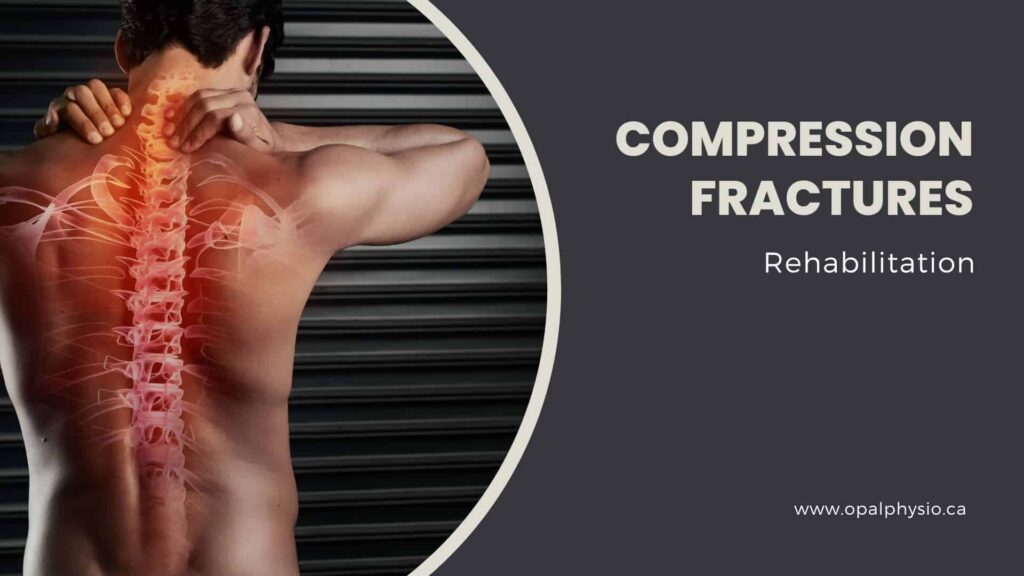Compression Fractures Rehabilitation
A compression fracture is a spinal injury that occurs when one or more vertebrae collapse or become compressed. This can be caused by osteoporosis, trauma, infection, or cancer. Physiotherapy treatment for compression fractures aims to reduce pain, improve function, and prevent further injury.
Compression Fractures Rehabilitation in Langley
At Opal Physio, we understand that dealing with a compression fracture can be a challenging and painful experience. Our specialized team of experienced physiotherapists is dedicated to helping you recover and regain your strength, mobility, and quality of life after a compression fracture.
Our physiotherapist can also help with pain management, a common symptom following these injuries and can help improve your function.

What is a compression fracture?
A compression fracture is a common type of fracture in the spine when the load on a vertebral body exceeds the bone’s strength. It happens when a vertebra collapses or is compressed due to excessive pressure or trauma.
Compression fractures mainly occur in the mid-thoracic part of the spine and the lower thoracic area but can happen to any bone in the body. In the elderly, compression fractures are also known as osteoporotic fractures. They are also called “spinal fractures” or “vertebral compression fractures “in other situations that caused the fracture.
Types of compression fractures:
There are three types of compression fractures in the spine – anterior, posterior and central. The most common compression fracture is the anteroposterior compression fracture. This fracture happens when a person falls and injures their spine.
Other common compression fractures include those in the hip( femur), knee and ankle joints; these are often called “stress fractures” because they most often occur during increased physical stress on the body and trauma. These types of fractures are diagnosed through X-ray imaging.
Causes of compression fractures
Compression fractures can be caused by some orthopedic injuries, such as:
Compression fractures symptoms
This type of fracture symptoms includes
Risk factors for compression fractures
The most common cause of compression fracture is osteoporosis, a condition characterized by low bone density and an increased risk for fracture. Osteoporosis can lead to compression fractures in multiple locations, including the spine, hips, feet, ribs and hands.
The other risk factors for compression fractures include:
How to reduce your risk of compression fractures?
- Maintain bone health: Consume a calcium and vitamin D diet to strengthen your bones.
- Exercise regularly: Engage in weight-bearing and muscle-strengthening exercises to improve bone density and overall strength. This can help reduce the risk of fractures due to falls or other accidents.
- Avoid excessive alcohol consumption: Limit your alcohol intake, as excessive consumption can negatively impact bone health.
- Quit smoking: Smoking can weaken bones and increase the risk of fractures. Quitting smoking is essential for maintaining bone health.
- Manage underlying conditions: If osteoporosis or other conditions increase the risk of compression fractures, work with your healthcare provider to manage these conditions effectively.
- Prevent falls: Minimize fall risks by clearing clutter from your home, installing handrails along stairways, and using non-slip mats in the bathroom.
- Be cautious with movements: Avoid twisting your back too quickly or far, and be mindful when lifting heavy objects or engaging in activities that may strain your spine.
Adopting these lifestyle changes and working closely with your healthcare provider, you can reduce your risk of compression fractures and maintain a healthy spine.
Management of compression fractures
Fractures can be treated through various methods depending on the severity and location of the injury.
Conservative treatment approach:
Medication: to help manage pain symptoms
Brace: The most common treatment is to immobilize and protect the injured area with a brace. The brace helps protect the fractured vertebrae in the spine and can ease the pain. Patients are usually advised to wear a brace for moving but avoid doing strenuous activities that might put too much pressure on their backs. In severe cases, a brief period of bed rest may be recommended by your doctor.
Surgical treatment: Compression fractures may also be treated with surgery, including inserting screws into the fractured bone or using metal plates to hold pieces of the broken bone together.

Physiotherapy rehabilitation for compression fractures:
Physiotherapy rehabilitation helps restore mobility and strength to the spine or the area that has been injured or immobilized for a time period.
Rehabilitation after a vertebral compression fracture is prolonged and can take weeks to months. Physiotherapy treatment for a spinal compression fracture usually is provided once the fracture has been stabilized and cleared for mobility.
Our approach to compression fracture recovery
Our comprehensive approach to compression fracture recovery centers on personalized care and evidence-based treatments. Our experienced physiotherapists will work closely with you to create a tailored treatment plan for your needs and goals.
Our main objectives during the recovery process are as follows:
- Pain management
- Restoring mobility and flexibility
- Rebuilding strength
- Improve posture and body mechanics.
- Improve balance and coordination.
- Education and self-management
Our focus on treatment includes the following:
In most cases, compression fractures heal within 8 to 10 weeks. However, the recovery time can vary depending on the fracture’s severity, underlying conditions such as osteoporosis, and the individual’s overall health. It is essential to follow the guidance of a healthcare professional and a physiotherapist to ensure a safe and effective recovery.
During the recovery, avoiding heavy lifting and intense activities that may exacerbate the injury is crucial. As the physiotherapist recommends, gentle exercises can help improve muscle tone, ease tension, and reduce muscle spasms in the back. Regular follow-up visits with your healthcare provider to monitor the healing process and adjust the treatment plan are also essential.
Take a step toward your recovery after a compression fracture!
Regain control over your life and embark on a journey to recovery with the help of our dedicated physiotherapy team. Book an appointment today at Opal Physio and take the first step towards a pain-free and active lifestyle. Our compassionate and skilled physiotherapists are eager to assist you in every aspect of your compression fracture recovery. Let us be your partners in health and healing.
